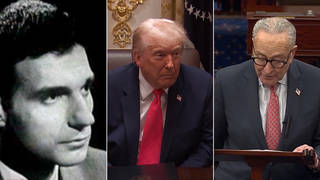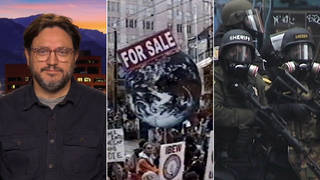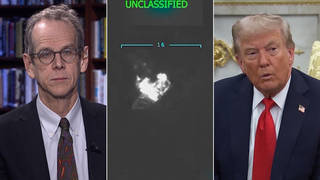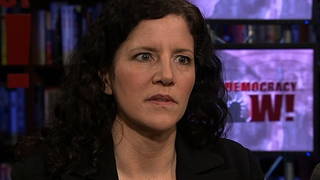
Guests
- William Binneyserved in the NSA for over 30 years, including a time as director of the NSA’s World Geopolitical and Military Analysis Reporting Group. Since retiring from the NSA in 2001, he has warned that the NSA’s data-mining program has become so vast that it could “create an Orwellian state.”
Links
- Surveillance Teach-in with Laura Poitras, Jacob Appelbaum and William Binney at the Whitney Museum, April 20
- “The NSA Is Building the Country’s Biggest Spy Center (Watch What You Say),” by James Bamford. (Wired Magazine, March 15, 2012)
- “Exposed: Inside the NSA’s Largest and Most Expansive Secret Domestic Spy Center in Bluffdale, Utah” (Democracy Now, March 21, 2
- “The Secret Sharer: Is Thomas Drake an enemy of the state?” by Jane Mayer. (New Yorker, May 23, 2011)
In his first television interview since he resigned from the National Security Agency over its domestic surveillance program, William Binney discusses the NSA’s massive power to spy on Americans and why the FBI raided his home after he became a whistleblower. Binney was a key source for investigative journalist James Bamford’s recent exposé in Wired Magazine about how the NSA is quietly building the largest spy center in the country in Bluffdale, Utah. The Utah spy center will contain near-bottomless databases to store all forms of communication collected by the agency, including private emails, cellphone calls, Google searches and other personal data.
Binney served in the NSA for over 30 years, including a time as technical director of the NSA’s World Geopolitical and Military Analysis Reporting Group. Since retiring from the NSA in 2001, he has warned that the NSA’s data-mining program has become so vast that it could “create an Orwellian state.” Today marks the first time Binney has spoken on national television about NSA surveillance. This interview is part of a 5-part special on state surveillance. Click here to see segment 2, 3, 4 and 5. [includes rush transcript]
Transcript
JUAN GONZALEZ: Today we bring you a Democracy Now! special on the growing domestic surveillance state and the Department of Homeland Security’s efforts to spy on dissident journalists and activists. In a national broadcast exclusive, we’re joined by National Security Agency whistleblower William Binney. He was a key source for James Bamford’s recent [exposé] in Wired Magazine about the NSA—how the NSA is quietly building the largest spy center in the country in Bluffdale, Utah. The Utah spy center will contain nearly bottomless databases to store all forms of communication collected by the agency, including private emails, cellphone calls and Google searches and other personal data.
Binney served in the NSA for over 30 years, including a time as director of the NSA’s World Geopolitical and Military Analysis Reporting Group. Since retiring from the NSA in 2001, he has warned that the agency’s data-mining program has become so vast that it could, quote, “create an Orwellian state.” Today marks the first time Binney has spoken on national television about surveillance by the National Security Agency.
AMY GOODMAN: We’re also joined by two individuals who have been frequent targets of government surveillance: Laura Poitras, the Academy Award-nominated filmmaker, and Jacob Appelbaum, a computer security researcher who has volunteered with WikiLeaks. Poitras is the director of the documentary films My Country, My Country and The Oath. Both Poitras and Appelbaum have been repeatedly detained and interrogated by federal agents when entering the United States. Their laptops, cameras and cellphones have been seized, and presumably their data has been copied.
The Justice Department has also targeted Appelbaum’s online communications. In November, a federal judge ordered Twitter to hand over information about his account. In October, the Wall Street Journal revealed the Justice Department had obtained a secret court order to force Google and the internet provider Sonic.net to turn over information about Appelbaum’s email accounts.
William Binney, Laura Poitras and Jacob Appelbaum will be speaking tonight at the Whitney Museum here in New York for a teach-in on surveillance. The three of them join us here in our studio together in a broadcast for the first time. We’re going to begin with William Binney.
You worked for the National Security Agency for more than three decades.
WILLIAM BINNEY: Almost four.
AMY GOODMAN: Almost four decades.
WILLIAM BINNEY: Yeah.
AMY GOODMAN: You, for a time, directed the NSA’s World Geopolitical and Military Analysis Reporting Group. Tell us what you did and then why you left and what happened to you afterwards.
WILLIAM BINNEY: Well, I was the technical director of that group, that basically looked at the world, so we looked at all the technical problems of—in the world, and see how we could solve collection, analysis and reporting on military and geopolitical issues all around the world, every country in the world. So, it was a rather large technical problem to tackle, but it—and one of the largest problems we thought we had was looking at the World Wide Web and all the ballooning and mushrooming communications in the world. And our ability to deal with that was diminishing over time, so I kind of referred to it as our inability to keep up with the rate of change. So, we were falling behind the rate of change.
So we—I had a very small group of people in a lab, and we decided to attack that problem. And we did it by looking at how we could graph the network of communications and all the communications in the world, and then—and then focus in on that graph and use the graph to limit what we wanted to attack. And we basically succeeded at that, but in the process, of course, we scooped up Americans from different places, so we had to protect their identities, according to our laws and privacy rights of U.S. citizens. So, under USSID 18, we built in protections to anonymize their identities, so you couldn’t really tell who you were looking at.
JUAN GONZALEZ: And that’s because the NSA could do surveillance from abroad, but not of U.S. citizens.
WILLIAM BINNEY: Well, and, you see, the World Wide Web routes things all over, so you never really know where U.S. citizens’ communications are going to be routed. So, you—if you were collecting somewhere else on another continent, you could still get U.S. citizens. That’s—see, that was a universal problem. So we devised how to do that and protect U.S. citizens. So—and this was all before 9/11. And we devised how to do that, made that effective and operating. So we were actually prepared to deploy about eight months before 9/11 and actually have a system that would run and manage the—what I call 20 terabytes a minute of activity.
So—but after 9/11, all the wraps came off for NSA, and they decided to—between the White House and NSA and CIA, they decided to eliminate the protections on U.S. citizens and collect on domestically. So they started collecting from a commercial—the one commercial company that I know of that participated provided over 300—probably, on the average, about 320 million records of communication of a U.S. citizen to a U.S. citizen inside this country.
AMY GOODMAN: What company?
WILLIAM BINNEY: AT&T. It was long-distance communications. So they were providing billing data. At that point, I knew I could not stay, because it was a direct violation of the constitutional rights of everybody in the country. Plus it violated the pen register law and Stored Communications Act, the Electronic Privacy Act, the intelligence acts of 1947 and 1978. I mean, it was just this whole series of—plus all the laws covering federal communications governing telecoms. I mean, all those laws were being violated, including the Constitution. And that was a decision made that wasn’t going to be reversed, so I could not stay there. I had to leave.
JUAN GONZALEZ: And I wanted to get back to, for a moment, when you say that you were developing a way to cope with the fact that the agency was falling behind, just because the sheer volume of the material that they were sweeping up was so great, that it was impossible, at times, to find the important intelligence material.
WILLIAM BINNEY: Yes.
JUAN GONZALEZ: So you, in essence, were creating a program that filtered out the valuable stuff.
WILLIAM BINNEY: Right. That’s right.
JUAN GONZALEZ: What—did it have a name, the program?
WILLIAM BINNEY: Well, it was called Thin Thread. I mean, Thin Thread was our—a test program that we set up to do that. By the way, I viewed it as we never had enough data, OK? We never got enough. It was never enough for us to work at, because I looked at velocity, variety and volume as all positive things. Volume meant you got more about your target. Velocity meant you got it faster. Variety meant you got more aspects. These were all positive things. All we had to do was to devise a way to use and utilize all of those inputs and be able to make sense of them, which is what we did.
JUAN GONZALEZ: And when they didn’t use your system, they—the NSA developed another or attempted to develop another system to do the same?
WILLIAM BINNEY: Well, that one failed. They didn’t produce anything with that one.
AMY GOODMAN: And that one was called?
WILLIAM BINNEY: Trailblazer, yeah.
AMY GOODMAN: Trailblazer, and—
WILLIAM BINNEY: I called it—I called it five-year plan number one. Five-year plan number two was Turbulence. Five-year plan number three is—
AMY GOODMAN: And Trailblazer cost how much money?
WILLIAM BINNEY: That was, I think, in my—my sense, was a little over $4 billion.
AMY GOODMAN: Four billion dollars.
WILLIAM BINNEY: Right.
AMY GOODMAN: But it was scuttled. It was done away with in 2006?
WILLIAM BINNEY: Yes, '05, I think it was. But yes, that's right. And we developed our program with $3 million, roughly.
JUAN GONZALEZ: And Trailblazer was largely developed by SAIC, the—
WILLIAM BINNEY: Well, they were contributing contractors, yeah. But they—I think they had the lead—they were the lead contractors in some of contracts, yeah.
AMY GOODMAN: And why did they go with this one, though, ultimately, they did not use it? This is under Michael Hayden at the time?
WILLIAM BINNEY: Yes. Well—
AMY GOODMAN: Under the Bush administration?
WILLIAM BINNEY: Well, I thought—my sense was it was a good employment program. And it was a large budget program. It would spend money, a lot of money, so it would build the budget and—
AMY GOODMAN: Go to a major weapons manufacturer.
WILLIAM BINNEY: Right.
AMY GOODMAN: And heads of the agency, National Security Agency, would go back and forth working at NSA, working at SAIC.
WILLIAM BINNEY: It was—we called it an incestuous relationship, yeah.
AMY GOODMAN: What happened to you after you quit? You quit within a month of the 9/11 attacks.
WILLIAM BINNEY: Thirty-first of October of 2001, yeah.
AMY GOODMAN: And then what happened?
WILLIAM BINNEY: Well, we tried to form out the company to at least help the government to deal with some of the massive data problems they had, like in—even in the FBI, and also Customs and Border Protection and NRO and various other agencies. And every time we went somewhere to try to develop something, why, we got canceled, our contract got canceled, for—basically because, we have heard, anyway, that they were told that certain agencies didn’t want them hiring us, so they didn’t want us working for them, so…
JUAN GONZALEZ: And before you left, in that short period when it became obvious to you the direction that the NSA was going to, did you—when you raised objections or raised concerns, what was the response?
WILLIAM BINNEY: Well, I went directly to the Intelligence Committee, because it was their job to—because, first of all, when that happened, I mean, the people they had to use to set it up—since they used part of the program we developed to set it up, they had to use our people to set it up, initially, because no one else knew the code, and no one else knew how to get it operating. So, when they did that, they came—those people came to me and said, “You know, they’re doing this,” you know, and they told me what they were doing. And so I immediately went to the Intelligence Committee, because they were—the intelligence committees were formed to have oversight over the intelligence community to make sure they didn’t monitor U.S. citizens. This was a fallout of the Church Committee back in the '70s. And the member of the staff that I went to went to Porter Goss, who was chairman of that committee at the time, and he referred her to General Hayden for any further. When it was the job of that committee to do the oversight on all this domestic spying, they weren't doing it, OK? Basically, the—at the time, according to Dick Cheney’s interview on the 10th anniversary of 9/11, he said the—at that time, only the majority or minority leaders, the HPSCI and the SSCI, were involved in having knowledge about this program, Stellar Wind, which you had talked with Tom Drake about.
AMY GOODMAN: The former NSA—
WILLIAM BINNEY: Right, right.
AMY GOODMAN: —employee who was also a whistleblower.
WILLIAM BINNEY: And that was the program, of course, that Director Mueller reported was the issue that—with the hospital visit with Ashcroft. So—
AMY GOODMAN: And explain that, very briefly, for—to remind people.
WILLIAM BINNEY: Well, the whole program, I guess, had to be reauthorized every 45 days, and they had to have the director of NSA, director of CIA and the attorney general sign an affidavit that they still needed the program and that it was legal. And when Comey and Goldsmith in the DOJ decided that this really was a violation of the Constitution and was illegal, then that issue came up. And that’s what—that’s what got everybody kind of disturbed and ready to—ready, actually, to resign in 2004, early 2004, I believe that was. And as a part of it was coming up for reauthorization, and so Gonzales left the White House, along with one other person I can’t remember, and went to the hospital where Ashcroft was, because he was—had pancreatitis, I believe, and was in the hospital, and Comey was the acting attorney general. And so, at that point, they went to Ashcroft to see if he would overrule Comey, who had denied reauthorization and declared it basically illegal. And so, they tried to get Ashcroft to overrule that and went to the hospital to do that. And Director Mueller, I think, also quickly got to the hospital to help ensure that Ashcroft was not taken advantage of, I guess. So…
AMY GOODMAN: When was your home raided?
WILLIAM BINNEY: Twenty-sixth of July of 2007.
AMY GOODMAN: What happened? Where did you
WILLIAM BINNEY: I should—I should say that it was the morning of the second day after Gonzales’s testimony, the then-Attorney General Gonzales’s testimony, to the Senate Judiciary Committee on the TSP, the—what was called the TSP, which I refer to as a fabricated plan. It was created to cover a number of plans, one of which was Stellar Wind, and the others—which they didn’t want to discuss. And the others were wiretapping. And so, they picked on the wiretapping ones, because the public would generally say, “Yes, anybody that was potentially a terrorist, a foreign terrorist, communicating with anybody in the United States, we want you to monitor their communications.” So that was the acceptable part of it. But it was grouped with Stellar Wind and some other programs, so that they could give cover to it, talk about some programs, say they’re talking about the Terrorist Surveillance Program, but it was basically a group of programs, some of which they did not want to talk about. And he did not testify to that at the—and I believe some of the—Whitehouse and Feingold, I think, were the two who were on the Senate Intelligence Committee that did challenge him at the time, saying he wasn’t being truthful, and that was—he wasn’t being completely honest. So…
AMY GOODMAN: You live where?
WILLIAM BINNEY: I live in Maryland, actually four miles from NSA.
AMY GOODMAN: And what happened?
WILLIAM BINNEY: They came busting in.
AMY GOODMAN: Who’s “they”?
WILLIAM BINNEY: The FBI. About 12 of them, I think, 10 to 12. They came in with the guns drawn, on my house.
AMY GOODMAN: Where were you?
WILLIAM BINNEY: I was in the shower. I was taking a shower, so my son answered the door. And they of course pushed him out of the way at gunpoint and came running upstairs and found me in the shower, and came in and pointed the gun at me while I was, you know—
AMY GOODMAN: Pointed a gun at your head?
WILLIAM BINNEY: Oh, yeah. Yes. Wanted to make sure I saw it and that I was duly intimidated, I guess.
JUAN GONZALEZ: And what did they—what did they do at that point? Did they begin questioning you? Or they just took you to headquarters? Or—
WILLIAM BINNEY: No, no. Yeah, they basically separated us from—I was separated from my family. Took me on the back porch, and they started asking me questions about it. They were basically wanting me to tell them something that would implicate someone in a crime. And so, I told them that I didn’t really know—they wanted to know about certain people, that was—they were the ones that were being raided at the same time, people who—we all signed—those who were raided that day, all of us signed the DOD-IG complaint. We were the ones who filed that complaint.
AMY GOODMAN: The Pentagon—
WILLIAM BINNEY: The Pentagon DOD-IG, against—
AMY GOODMAN: —inspector general complaint.
WILLIAM BINNEY: Against NSA, yes, talking about fraud—basically corruption, fraud, waste and abuse. And then—
AMY GOODMAN: Tom Drake was raided at the same time?
WILLIAM BINNEY: No, he was raided in November of that year. We were just the ones who signed it, were raided.
JUAN GONZALEZ: So, and who were the other people that were raided that same day?
WILLIAM BINNEY: Diane Roark, Kirk Wiebe and Ed Loomis.
AMY GOODMAN: Diane Roark worked for the Senate committee?
WILLIAM BINNEY: Diane was the senior staffer. She had the NSA account on the HPSCI side, on the House side. So she was monitoring. She was doing oversight. She was doing real oversight; the others weren’t. Basically, the others were simply taking what the NSA said verbatim and taking them at their word. So, basically, that was not oversight. But Diane would probe and be prying into what they were saying to find out really clearly what was going on. And—
JUAN GONZALEZ: And ostensibly, they were searching for who was leaking information to the—who had leaked information to the New York Times.
WILLIAM BINNEY: That was the pretext, yes. But I accused them of being sent there by someone outside the FBI. And that—their body language told me that I hit it right on the head. So—and I also—after a while, they were questioning me, and I couldn’t tell them anything, because I didn’t know anything that would implicate any of the four of us, so—
AMY GOODMAN: They were looking for leaks.
WILLIAM BINNEY: Well, that was the pretext, the leak on the—to give the New York Times thing. The real thing—what they were really doing was retribution and intimidation so we didn’t go to the Judiciary Committee in the Senate and tell them, “Well, here’s what Gonzales didn’t tell you, OK.” That was what it was really all about. And also, it was retribution for that DOD-IG complaint, because it was a rather embarrassing report that they gave, so…
JUAN GONZALEZ: And what is it that Gonzales didn’t tell them, in your perspective, in terms of what is happening to our national security surveillance situation?
WILLIAM BINNEY: Well, it was about—it was about Stellar Wind and all of the domestic spying.
AMY GOODMAN: We’re going to break and come back to this conversation. William Binney was the technical director of the National Security Agency, which, by the way, is a number of times larger than the CIA, the National Security Agency’s World Geopolitical and Military Analysis Reporting Group. When we come back, we’ll also speak with a well-known hacker, Jacob Appelbaum, who has volunteered for WikiLeaks—he’s a computer security researcher—and Laura Poitras, whose films, My Country, My Country and The Oath, are well known. She’s been nominated for an Oscar. This is Democracy Now! Back in a minute.
This interview is part of a 4-part special. Click here to see segment 2, 3, and 4.











Media Options